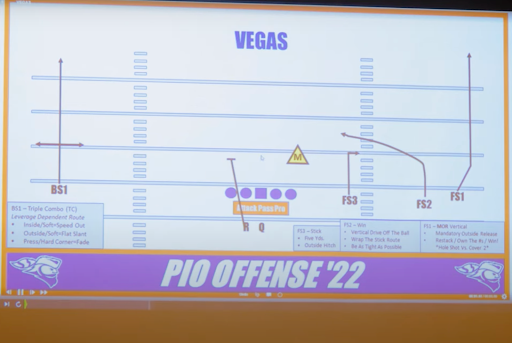The stick concept is a simple play design that allows quarterbacks to have success in any down and distance situation because of its ability to let the quarterback determine leverage and make pre-snap reads. By doing so, the quarterback is able to create easy pitch and catch opportunities based on his analysis of the defense.
This is why Mike Budzisewski of Carroll University says it's one of his most frequently called plays which nets his team an average of 10.3 yards per catch.
In an effort to protect his team’s best play, Carroll University’s Mike Budzisewski has implemented 4 specific variations of the stick concept to continue attacking defenses at a high level. By having multiple play calling options stemming from one core play design, Coach Budzisewski is able to keep defenses on their toes and unable to guess what is coming next.
At its core, the stick concept is a play run from a 3x1 formation in which the back side receiver typically runs a called in route of the coach’s choice, while the stick concept is run to the field side. The field side number 1 receiver stresses the defense by pushing the outside corner vertically while the field side number 2 receiver and tight end attack underneath. The field side number 2 typically runs an outward breaking route while the tight end or field side number 3 run the actual stick route.
Watch the video to learn more, or scroll down to read about the specific variations of the stick concept covered in this video.
Stick Concept Variations - Stagger
The first, and most fundamental stick-variation that Coach Budzisewski has implemented into his offense is the Stagger concept (See diagram below).

The 3x1 look that this presents defenses with puts the outside linebackers in a tough position to have success and opens up the opportunity for the quarterback to attack the underneath routes. Depending on the alignment of the Mike linebacker and OLBs, the quarterback can make a pre-snap decision regarding whether he is going to target the speed out or the stick route.
If the outside linebacker has inside leverage and sits on the stick route, then the quarterback should hit the speed out. If he chases the speed out, then the Mike linebacker is in a bad position to try and recover to the stick before the ball arrives. This is how the quarterback can create repeated 5 yard pitch and catch opportunities with a simple concept. If the quarterback doesn’t like what he sees to the field side, and the back side safety is shaded to the middle of the field, he can also go back to the Dino route on the back side 1.

Here, the outside linebacker has inside leverage on the field side number 2 receiver which creates the opportunity for the quarterback to diagnose that he can create speed in open space. On this play he hits the field side 2 on the speed out for a 1st down
Stick Concept Variations - Snap

The second variation of this concept is Snap. Instead of the back side 1 running a Dino route, this time he’ll run to the middle of the alley and sit down at about 4-5 yards. The tailback will spill out of the backfield and replace the outside foot of the outside receiver. The field side remains the same as in the Stagger concept. This is one of Coach Budzisewski’s favorite plays in the red zone.
(See diagram below)

This play is an example of Snap. The pre-snap leverage shows the defense lining head-up on the field side number 2, so the quarterback sees the space that will be left open to hit the stick route as a result of the soft coverage and vacated space after number 2 runs the out.
Stick Concept Variations - Vegas

The Vegas concept is the first variation that begins to change the patterns on the field side of the formation. In this call, the speed out turns into a wrap route about 2 yards behind the number 3 receiver. This is not a slant route. The distinction between the two is important. The depth of this route depends on how deep the tight end runs his stick route. This creates a mismatch by running number 2 off the butt of an inside linebacker who attacked the stick route and doesn’t have the lateral quickness to recover after vacating his pre-snap alignment.
Stick Concept Variations - Nod

Nod is another one of Coach Budzisewski’s favorite and most effective red zone options. In this variation, the field side combinations are edited to create more vertical pressure on the defense. Instead of running a normal stick route, the tight end takes 2 steps into his outward breaking stick route and then turns it up field.
Additionally, the field side 2 runs an inward breaking whip route which replaces the inside linebacker that runs with the tight end pressing vertically. If the linebacker does not run with the tight end, then the vertical portion of the stick should get open.
Want More?
If you're looking for more background on the stick concept, CLICK HERE.
